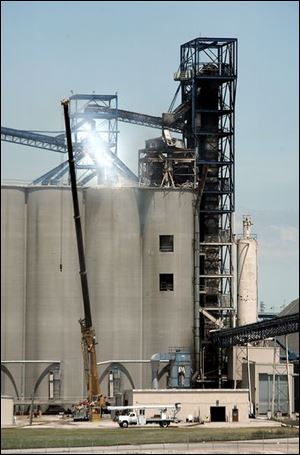
Stubborn blaze keeps crews at grain elevator
7/3/2005
Battalion Chief Eric Renzhofer says fire crews continue to pour water on the stubborn blaze at the riverfront grain silo.
Allan Detrich / Blade

A crane was used to lift workers to view the damage.
More than 24 hours after a pair of explosions rocked The Andersons/Cargill grain elevator along the Maumee River, the threat of a third blast kept firefighters from entering the facility yesterday.
Officials said it could be several days before they determine the cause of the fire.
"Multiple seven figures. Easily," said James M. McKinstray when asked to estimate the loss that could run into the millions of dollars.
Mr. McKinstray, general manager of The Andersons Inc. Maumee Grain facilities, simply shook his head and said to "use adjectives instead of numbers" when trying to put the damage into context.
He said the loss has the potential of being so staggering that it is impossible for him to quantify with a dollar amount.
The immediate focus continues to be on the safety of firefighters battling the blaze.
Sorting out the damage eligible to be covered by insurance is a task for another time, he added.
Toledo Fire Chief Michael Bell and Eric Renzhofer, a city fire battalion chief, said they were keeping firefighters in a defensive posture.
The crews were spraying the smoldering fire with water from a distance, rather than moving into the 160-foot-high concrete grain silo and attacking the blaze head on. The threat of another explosion is expected to dissipate as the grain becomes wetter, reducing the amount of explosive dust.
The intensity and heat of the blaze are expected to remain strong for days because of a pool of molten rubber that is believed to be inside the silo.
Chunks of rubber from the 5-foot-wide conveyor belt are believed to have fallen into the silo, officials said. Tons of foam brought in from the BP refinery in Oregon and the 180th Air National Guard at Toledo Express Airport were used to control the fire Friday night.

Battalion Chief Eric Renzhofer says fire crews continue to pour water on the stubborn blaze at the riverfront grain silo.
Chief Renzhofer said foam is only effective when applied to concentrated flames.
Crews phased down their use of the material yesterday because the number of hot spots became scattered.
Firefighters were still battling flare-ups at the silo after 8:30 last night when fire flared along a section of rubber conveyor, producing thick smoke.
"It was black as it was the first day," Lt. Ke Goolsby said.
At least one additional fire engine was called to the scene, and firefighters again trained foam on the damaged structures.
"We thought we had it under control and then we went, 'Oh, man,'" Lieutenant. Goolsby said. "It's those spot fires. We just keep trying to keep the temperature down."
Foam was being stockpiled in the event the fire gained momentum, Chief Renzhofer said.
Chief Bell also said the city has access to foam from other parts of Ohio under a statewide mutual-aid pact created by the Homeland Security Act.
The fire was reported at 3:39 p.m. Friday, nearly 40 minutes after employees had left for the holiday weekend. No injuries were reported, even though the blast hurled sheets of metal skyward.
Authorities closed nearby I-75 during rush-hour for about four hours because of the potential for another explosion.
At one point, flames shot off a conveyor belt 150 feet in the air.
The city fire department's largest piece of apparatus only has a 110-foot extension.
A Toledo police helicopter yesterday took a city fire investigator up for aerial photographs.
Chief Renzhofer said some firefighters scaled a crane, but only briefly. He said the photographs confirmed the department was taking the best approach by slowing the fire from the outside and concentrating on containment.
Chief Bell said he wanted time on ladders to be limited for the safety of firefighters, at least until the fire dies out.
He said the aerial photography would help give a panoramic view of the damage from above, including weakened roof spots that might collapse.
One problem was exposure to toxic, petroleum fumes from the burning rubber, Chief Bell said.
Investigators include Kyle Walton, the federal Bureau of Alcohol, Tobacco and Firearms' agent in charge in Toledo, and Keith Loreno, of the state fire marshal's fire and explosion investigation bureau.
Both said they would be looking at debris and interviewing employees and witnesses, as well as gathering evidence from inside the elevator.
They said their presence was standard for a major explosion and did not indicate a suspicion of sabotage. "There's no evidence of any foul play or anything criminal," Mr. Walton said.
Some $7 million to $10 million of grain was inside the silo.
While it is unknown how much of that can be salvaged, the cost of rebuilding or replacing the structure itself will be in the millions. If the structure can't be rebuilt, the cost of building a new grain elevator would undoubtedly be in the "tens of millions" in today's market, Mr. McKinstray said.
The grain elevator that caught fire is one of four operated by The Andersons, but one of only two along the Maumee River.
The Andersons' capacity to serve its marine markets "has essentially been halved," Mr. McKinstray said. That, he conceded, has the potential to cause at least some short-term complications in operations.
"Its loss will be meaningful to The Andersons. I don't want to mislead anyone," Mr. McKinstray said.
Blade staff writer Mark Zaborney contributed to this report.
Contact Tom Henry at: thenry@theblade.com or 419-724-6079.